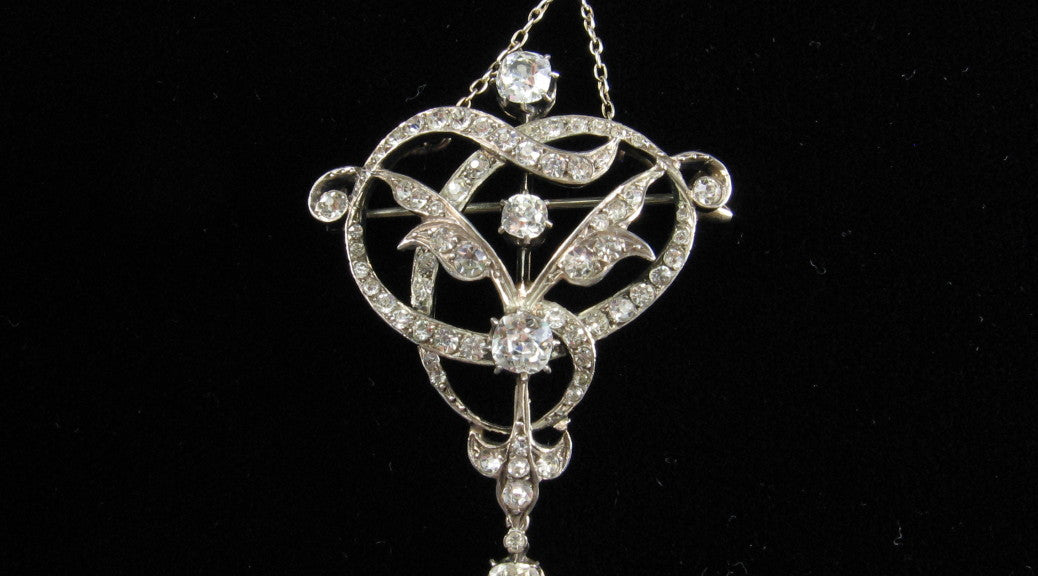I love fine paste jewelry from all eras and over the years I have had pieces dating from the Georgian era through the mid-20th century. Paste is glass that is meant to look like gemstones and when I refer to “paste”, as opposed to rhinestone, jewelry I distinguish it by the quality of its construction: paste jewelry is constructed just like fine jewelry using glass stones instead of gemstones in settings of gold or silver. However, not everyone uses the term in this manner; some people throw around the terms “paste” and “rhinestone” interchangeably.
According to M.D.S. Lewis in “Antique Paste Jewelry”, around 1830 the styles and construction of paste jewelry changed; since these changes occurred close to Queen Victoria’s ascension to the throne in 1837, we can refer to this next phase as Victorian. These changes were the result of industrialized production replacing hand construction; with changes in diamond cutting, which filtered down to paste jewelry; with changes in styles of fashion; and with international expositions which, starting with the Crystal Palace Exhibition in 1851, disseminated styles worldwide.

Belle Epoch Paste Pendant with Round and Cushion-cut Paste Stones
In the late 18th century the style of diamond cutting changed. What is now known as “old mine cut” or cushion cut, was adopted as the dominant cut in diamond jewelry, replacing the rose cut. As the second half of the 19th century progressed round stones, cut in the style now known as “old European cut”, became dominant. These uniform round stones also allowed for easier setting in stamped or cast settings. Paste jewelry followed these trend with round and cushion-cut stones replacing the unusually-shaped stones characteristic of 18th century paste jewelry.
Back of Belle Epoch Paste Pendant. Note Partly-worn Foil Coating on Open-backed Stones
Brilliant cut diamonds do not require foil backs so open-back settings were increasingly used, usually backed with gold for strength since silver was still often used for setting diamonds. These open-back settings were also adopted by paste manufacturers but since paste does not have the same optical properties as diamonds, open-back paste will not have the reflectivity of foil-backed paste. Fortunately, around 1840 the process of coating the back of glass stones with a thin film of silver was developed. This thin film replaced the foils used behind the stones in Georgian jewelry.
Some Victorian paste jewelry has settings that look like the cut-down collets of the Georgian era; however they are heavier, because they were cast, and for primarily for ornamentation. The Victorian watch pin below has a cast setting that looks like a Georgian-era crimped setting on the front, but is cast and open on the back, a give-away that it is a later piece.

Victorian Watch Pin with Cast Crimped-style setting.
Back of Watch Pin – Note Open Back of Setting
In 1892 Daniel Swarovskipatented a machine that could produce precisely-faceted and polished glass stones in a fraction of the time it had previously taken and also developed a method of vacuum-plating their backs with foil. These high-quality manufactured stones replaced hand-cut stones in paste jewelry. In addition, the widespread availability of inexpensjewelry was still being made. It generally followed prevailing styles of fine jewelry and, as you can see in the pieces below, was still superbly designed and constructed. This is a regal Edwardian paste tiara set in silver, with a ruby paste at its center. The detail is phenomenal, including the setting of the ruby paste in gilt silver, just like a ruby would have been set in gold:

Edwardian Paste Tiara
Here is a wonderful Art Deco paste brooch made in France, also set in silver with the rays of the shooting stars on different planes:

Art Deco Paste Brooch Made in France
Although most fine paste jewelry of the 20th followed current design trends, there was one English manufacturer, Harold A. Lazarus, who produced exquisite paste jewelry in earlier styles. In business from about 1900-1960, Lazarus wasn’t attempting to deceive anyone as his pieces were hallmarked and used modern findings. Even M.D.S. Lewis grudgingly referred to Lazarus’s reproductions of earlier styles as “skillful”, high praise from an author whose preference is for eighteenth century paste. This lovely paste flower spray by Lazarus is constructed and designed like a Victorian piece, yet it bears hallmarks dating it to 1952 and Lazarus’ maker’s mark of “HAL”.
Harold A. Lazarus Paste Brooch
Back of Lazarus Brooch Showing Hallmarks and Maker’s Mark
In the late 20th century, with the development of diamond substitutes like cubic zirconia (CZ), fine paste jewelry stopped being produced. Currently the market for antique and vintage paste jewelry is strong because its beauty and craftsmanship is exceptional, yet its cost is a fraction of comparable gemstone jewelry.
“Antique Paste Jewelry” by M.D.S. Lewis is out of print but sometimes available from re-sellers on Amazon or from J.M. Cohen Rare Books, a dealer who specializes in books about jewelry and fashion who I met this summer at Jewelry Camp.





